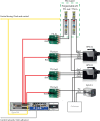Development of MHz X-ray phase contrast imaging at the European XFEL
- PMID: 39565194
- PMCID: PMC11708855
- DOI: 10.1107/S160057752400986X
Development of MHz X-ray phase contrast imaging at the European XFEL
Abstract
We report on recent developments that enable megahertz hard X-ray phase contrast imaging (MHz XPCI) experiments at the Single Particles, Clusters, and Biomolecules and Serial Femtosecond Crystallography (SPB/SFX) instrument of the European XFEL facility (EuXFEL). We describe the technical implementation of the key components, including an MHz fast camera and a modular indirect X-ray microscope system based on fast scintillators coupled through a high-resolution optical microscope, which enable full-field X-ray microscopy with phase contrast of fast and irreversible phenomena. The image quality for MHz XPCI data showed significant improvement compared with a pilot demonstration of the technique using parallel beam illumination, which also allows access to up to 24 keV photon energies at the SPB/SFX instrument of the EuXFEL. With these developments, MHz XPCI was implemented as a new method offered for a broad user community (academic and industrial) and is accessible via standard user proposals. Furthermore, intra-train pulse diagnostics with a high few-micrometre spatial resolution and recording up to 128 images of consecutive pulses in a train at up to 1.1 MHz repetition rate is available upstream of the instrument. Together with the diagnostic camera upstream of the instrument and the MHz XPCI setup at the SPB/SFX instrument, simultaneous two-plane measurements for future beam studies and feedback for machine parameter tuning are now possible.
Keywords: European XFEL; X-ray phase contrast imaging; indirect MHz X-ray detector; megahertz sampling; pulse-resolved imaging.
open access.
Figures












Similar articles
-
Online dynamic flat-field correction for MHz microscopy data at European XFEL.J Synchrotron Radiat. 2023 Nov 1;30(Pt 6):1030-1037. doi: 10.1107/S1600577523007336. Epub 2023 Sep 20. J Synchrotron Radiat. 2023. PMID: 37729072 Free PMC article.
-
Pump-probe capabilities at the SPB/SFX instrument of the European XFEL.J Synchrotron Radiat. 2022 Sep 1;29(Pt 5):1273-1283. doi: 10.1107/S1600577522006701. Epub 2022 Jul 21. J Synchrotron Radiat. 2022. PMID: 36073887 Free PMC article.
-
Shot-to-shot two-dimensional photon intensity diagnostics within megahertz pulse-trains at the European XFEL.J Synchrotron Radiat. 2022 Jul 1;29(Pt 4):939-946. doi: 10.1107/S1600577522005720. Epub 2022 Jun 8. J Synchrotron Radiat. 2022. PMID: 35787559 Free PMC article.
-
Dynamic Structural Biology Experiments at XFEL or Synchrotron Sources.Methods Mol Biol. 2021;2305:203-228. doi: 10.1007/978-1-0716-1406-8_11. Methods Mol Biol. 2021. PMID: 33950392 Review.
-
Serial femtosecond crystallography at the SACLA: breakthrough to dynamic structural biology.Biophys Rev. 2018 Apr;10(2):209-218. doi: 10.1007/s12551-017-0344-9. Epub 2017 Dec 1. Biophys Rev. 2018. PMID: 29196935 Free PMC article. Review.
References
-
- ASTRO.tech (2024). Fiebig Astrotechnik, https://astrocontrol.de/en/homepage/. [Online; accessed 3 June 2024.]
-
- Ayyer, K., Xavier, P. L., Bielecki, J., Shen, Z., Daurer, B. J., Samanta, A. K., Awel, S., Bean, R., Barty, A., Bergemann, M., Ekeberg, T., Estillore, A. D., Fangohr, H., Giewekemeyer, K., Hunter, M. S., Karnevskiy, M., Kirian, R. A., Kirkwood, H., Kim, Y., Koliyadu, J., Lange, H., Letrun, R., Lübke, J., Michelat, T., Morgan, A. J., Roth, N., Sato, T., Sikorski, M., Schulz, F., Spence, J. C. H., Vagovic, P., Wollweber, T., Worbs, L., Yefanov, O., Zhuang, Y., Maia, F. R. N. C., Horke, D. A., Küpper, J., Loh, N. D., Mancuso, A. P. & Chapman, H. N. (2021). Optica, 8, 15–23.
-
- Bajt, S., Prasciolu, M., Fleckenstein, H., Domaracký, M., Chapman, H. N., Morgan, A. J., Yefanov, O., Messerschmidt, M., Du, Y., Murray, K. T., Mariani, V., Kuhn, M., Aplin, S., Pande, K., Villanueva-Perez, P., Stachnik, K., Chen, J. P., Andrejczuk, A., Meents, A., Burkhardt, A., Pennicard, D., Huang, X., Yan, H., Nazaretski, E., Chu, Y. S. & Hamm, C. E. (2018). Light Sci. Appl.7, 17162. - PMC - PubMed
-
- Bean, R. J., Aquila, A., Samoylova, L. & Mancuso, A. P. (2016). J. Opt.18, 074011.
Grants and funding
LinkOut - more resources
Full Text Sources

